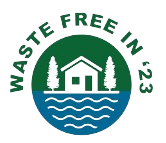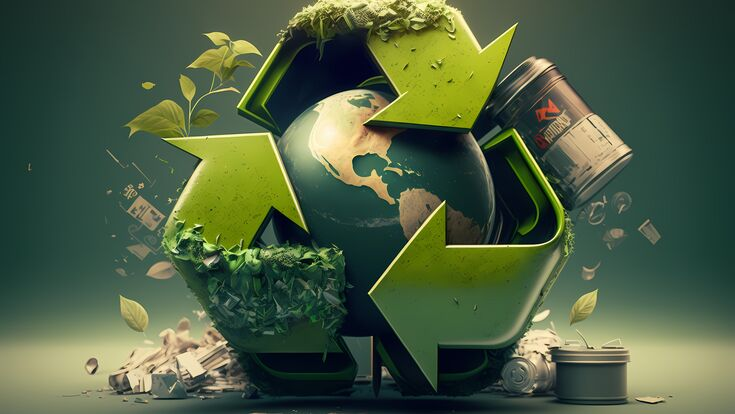Technical References & Research: All The Science Behind Waste Free '23

At Waste Free ’23, we are dedicated to tackling the global waste crisis with innovative, evidence-based solutions. We believe that strong scientific research is the cornerstone of effective and sustainable waste management practices.
Our methodology is not simply based on good intentions; it is informed by rigorous academic studies on waste processing, environmental impact, and so on. This commitment to transparency and scientific backing ensures that our solutions are not only effective in eliminating waste but also have a positive impact on the environment and the well-being of communities.
Articles on..
Plastic Processing
Investigation of Gas Release from Recycled Plastic Shopping Bags during Melting at Low Temperatures (Eberhard et al., 2023)
Parts of the Abstract: Recycling plastic is an excellent way to reduce the environmental impact of its production and use. In a circular economy, recycling of recycled plastic is necessary. Most plastic bags are made of thermoplastic, like high-density polyethylene (HDPE) with a melting point of 130°C, and low-density polyethylene (LDPE). In contrast, recycled plastic bags are made up of many different unknown substances. In this study, the melting of used plastic bags containing 80% unknown recycled material was investigated. FTIR analysis showed that the bags consisted mainly of HDPE.
The bags released small amounts of toxic phthalates. The results show that melting recycled plastic bags for remoulding is promising if safety precautions that ensure sufficient ventilation are utilised.
“Styrofoam Recycling – Smart Business Idea” (Warm Heart, 2023)
Parts of the Abstract: Warm Heart has developed a simple, replicable system to recycle Styrofoam and convert it into useful products like Styrofoam cement bricks. The project provides opportunities for individuals to build a sustainable business while helping clean the environment. The process involves collecting Styrofoam, grinding it into small “fuzz” particles, and mixing it with cement to create lightweight, durable bricks. These Styrofoam cement bricks can be used for building walls, roofs, and insulation. Warm Heart emphasizes that the system is low-cost and can be started with minimal investment, making it accessible to many communities.
Recommendation: Warm Heart recommends using Styrofoam cement bricks for non-load-bearing walls, roof insulation, and external applications. They suggest creating a brick-making machine to increase productivity and to follow safety guidelines, particularly regarding fire safety.
Toilet Waste Processing
Urea recovery from stabilized urine using a novel ethanol evaporation and recrystallization process (H. Marepula et al., 2021)
Parts of the Abstract: Urea is a raw material in the production of various chemicals and is a key nitrogen-based fertilizer. The conventional process to manufacture synthetic urea operates at high temperatures and pressures and is therefore energy intensive. The aim of this work was to investigate the feasibility of recovering and purifying urea crystals from human urine using a novel ethanol evaporation and recrystallization process that exploits the solubility differences of urea and impurities in water and ethanol. This approach could provide an alternative method to produce urea that operates at atmospheric pressure and low temperatures (< 30°C).
Nitrogen Recovery With Source Separation of Human Urine—Preliminary Results of Its Fertiliser Potential and Use in Agriculture (Viskan et al., 2018)
Parts of the Abstract: The growing demand for food and the increasing costs of cultivation are posing a challenge for agriculture. Diminishing phosphorus reserves, as well as the energy intensive method of producing nitrogen fertilisers are drivers for more intensive reuse of different organic fertilisers, such as manures and excreta. Source separation and fertilisation with human urine can be one option for nutrient reuse. Urine contains all the main nutrients as well as micronutrients in soluble form, but it also contains chemicals, like pharmaceuticals and hormones. The aim of this study was to examine the efficiency and safety of the use of source separated human urine as a fertiliser for barley (Hordeum vulgare).
Pharmaceuticals and hormones were found from the urine, but apart from progesterone, all of them presented extractable values in soil below the detection limits, and they were not detected in measurable amounts in barley grain at the end of the growing season. These results suggest that source separated urine could be an efficient fertiliser in crop cultivation.
Pyrolysis of Dry Toilet Substrate as a Means of Nutrient Recycling in Agricultural Systems: Potential Risks and Benefits (Bleuler et al., 2020)
Parts of the Abstract: Biochar is increasingly being applied as a soil amendment in agriculture. Biochar is typically produced from plant biomass and contains relatively low amounts of plant nutrients (e.g., N, P, and K), thus providing limited fertilizer value. Human excreta contains plant nutrients that could be recycled to create sustainable agricultural nutrient cycles. This study investigated the potential of biochar derived from a dry toilet substrate as soil amendment.
[Contd.] Based on these results, it is recommended that urine separation should be considered for biochar of excreta, which could reduce salt stress while maintaining concentrations of “fixed” or bioavailable nitrogen.
A comparison in product-value potential in four treatment strategies for food waste and faeces – assessing composting, fly larvae composting and anaerobic digestion (Lalander et al., 2017)
Parts of the Abstract: Municipalities are expected to provide solid waste management, which is funded by tax revenue or/and waste treatment fees. In many low- and middle-income countries, municipalities struggle to provide an adequate level of service, and in these places, the informal sector plays a major role in the collection and treatment of solid waste. In contrast to the plastic and metal fraction, the organic fraction is not managed by the informal sector, primarily because it has low or no financial value and treatment would cost more than the possible revenue. If the organic fraction could be converted to valuable products, the treatment could bear its own cost and this could act as an incentive to collect and treat this fraction. In this study, the potential product value generated through four treatment strategies treating food waste and faeces was compared in a Swedish context: (i) thermophilic composting; (ii) black soldier fly treatment (BSF treatment); (iii) anaerobic digestion (AD); and (iv) BSF treatment followed by AD (BSF + AD).
In places with an existing AD plant, BSF treatment + AD strategy is the most economically viable. In places where no such plant exists, BSF treatment is likely to be the most economically favourable treatment.
Carbon footprint of processing city market waste for animal feed with Black Soldier Flies in Kampala, Uganda (Pishgar-Komleh et al., 2022)
Summary: The study by Wageningen University assessed the carbon footprint of processing city market waste into black soldier fly larvae (BSFL) in Kampala, Uganda. Results showed that BSFL production emits 3.1 kg CO2eq per kg of dried larvae but avoids 9.7 kg CO2eq, yielding a net reduction of 5.2 kg CO2eq. BSFL can replace soybean meal and fishmeal in livestock feed, enhance local feed production, and improve organic waste management. The study recommends efficiency improvements and further research to optimize BSFL production’s environmental and economic benefits
Food & Other Organic Waste Processing
A comparison in product-value potential in four treatment strategies for food waste and faeces – assessing composting, fly larvae composting and anaerobic digestion (Lalander et al., 2017)
Parts of the Abstract: Municipalities are expected to provide solid waste management, which is funded by tax revenue or/and waste treatment fees. In many low- and middle-income countries, municipalities struggle to provide an adequate level of service, and in these places, the informal sector plays a major role in the collection and treatment of solid waste. In contrast to the plastic and metal fraction, the organic fraction is not managed by the informal sector, primarily because it has low or no financial value and treatment would cost more than the possible revenue. If the organic fraction could be converted to valuable products, the treatment could bear its own cost and this could act as an incentive to collect and treat this fraction. In this study, the potential product value generated through four treatment strategies treating food waste and faeces was compared in a Swedish context: (i) thermophilic composting; (ii) black soldier fly treatment (BSF treatment); (iii) anaerobic digestion (AD); and (iv) BSF treatment followed by AD (BSF + AD).
In places with an existing AD plant, BSF treatment + AD strategy is the most economically viable. In places where no such plant exists, BSF treatment is likely to be the most economically favourable treatment.
Carbon footprint of processing city market waste for animal feed with Black Soldier Flies in Kampala, Uganda (Pishgar-Komleh et al., 2022)
Summary: The study by Wageningen University assessed the carbon footprint of processing city market waste into black soldier fly larvae (BSFL) in Kampala, Uganda. Results showed that BSFL production emits 3.1 kg CO2eq per kg of dried larvae but avoids 9.7 kg CO2eq, yielding a net reduction of 5.2 kg CO2eq. BSFL can replace soybean meal and fishmeal in livestock feed, enhance local feed production, and improve organic waste management. The study recommends efficiency improvements and further research to optimize BSFL production’s environmental and economic benefits
Greenhouse Gas and Air Pollutant Emissions from Composting (Nordahl et al., 2023)
Summary: This study by Nordahl et al., published in Environmental Science & Technology, reviews the greenhouse gas (GHG) and air pollutant emissions from composting processes. The authors analyze 388 emission factors from 46 studies, focusing on CO₂, CH₄, N₂O, NH₃, and VOC emissions. The study highlights that CH₄ is the largest contributor to the 100-year global warming potential (GWP100) for yard waste composting, while N₂O is the largest for nitrogen-rich wastes like manure. Effective compost pile management, including aeration, can reduce CH₄ emissions but may increase NH₃ emissions. The review underscores the need for balanced landfill diversion goals with local air quality and odor concerns from composting facilities. The authors call for more standardized measurement techniques to improve data accuracy and support policy decisions.
Recommendations: To optimize composting’s environmental benefits, the study suggests:
- Improved management practices to minimize CH₄ and NH₃ emissions.
- Further research to refine emission factors and understand the impact of composting conditions and waste characteristics.
- Consideration of non-GHG emissions and their health impacts in surrounding communities.
The Effects of Two Organic Soil Amendments, Biochar and Insect Frass Fertilizer, on Shoot Growth of Cereal Seedlings (Carroll et al., 2023)
Summary: This study explores the effects of two organic soil amendments—biochar and insect frass fertilizer—on the shoot growth of cereal seedlings. Conducted through a series of greenhouse trials, the research assesses how these amendments impact the growth of four cereals grown in Ireland: barley, oats, triticale, and spelt. The findings indicate that low quantities of insect frass fertilizer, particularly from black soldier fly waste, significantly enhance shoot growth and nutrient concentration in these cereals, especially in low-nutrient soil conditions. However, excessive application can reduce growth or cause seedling mortality. Conversely, biochar did not show consistent positive or negative effects on shoot growth, suggesting limited potential for its use as a growth-promoting agent but potential benefits for carbon sequestration in soils.
Recommendation: Insect frass-based fertilizers appear beneficial in low-input and organic cereal production systems, while biochar’s utility may lie more in carbon storage than in enhancing plant growth.
Black Soldier Fly Biowaste Treatment – Assessment of Global Warming Potential (Mertenat et al., 2019)
Summary: Cities in low- and middle-income countries face significant challenges in managing increasing amounts of waste, especially the organic fraction. Black Soldier Fly (BSF) biowaste treatment is an attractive option, offering a solution for waste management and a protein source to meet rising global demand for animal feed. This study assesses the global warming potential (GWP) of a BSF waste treatment facility in Indonesia using a life cycle assessment (LCA) approach. The results indicate that direct greenhouse gas emissions from BSF treatment are 47 times lower than those from composting. Additionally, the overall GWP of the BSF treatment facility is half that of a composting facility per ton of biowaste. The study suggests that BSF biowaste treatment is an environmentally beneficial alternative with low direct GHG emissions and potential for significant GWP reduction.
Recommendations: To further reduce environmental impacts, the study recommends improving residue post-treatment processes and considering renewable energy sources for electricity needs in BSF facilities.
Got questions?

